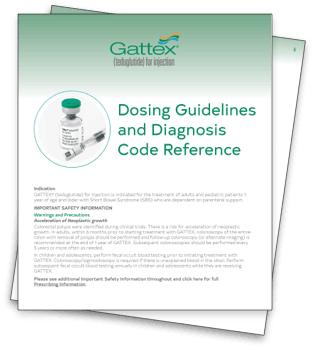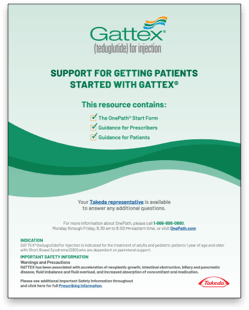Indication
GATTEX® (teduglutide) for injection is indicated for the treatment of adults and pediatric patients 1 year of age and older with short bowel syndrome (SBS) who are dependent on parenteral support.
Important Safety Information
Warnings and Precautions
Acceleration of Neoplastic growth
Intestinal polyps were identified during clinical trials. Postmarketing cases of colorectal, gastric, and small intestinal (duodenum, ileum, and jejunum) polyps have been reported. There is a risk for acceleration of neoplastic growth. In adults, within 6 months prior to starting treatment with GATTEX, perform colonoscopy and an upper gastrointestinal (GI) endoscopy with removal of polyps. A follow-up colonoscopy and upper GI endoscopy (or alternate imaging) is recommended at the end of 1 year of GATTEX. Subsequent colonoscopies and upper GI endoscopies (or alternate imaging) should be performed every 5 years or more often as needed. If a polyp is found, adherence to current polyp follow-up guidelines is recommended.
In pediatric patients, perform fecal occult blood testing within 6 months prior to initiating treatment with GATTEX. If there is new or unexplained blood in the stool, perform colonoscopy/sigmoidoscopy and an upper GI endoscopy. Perform subsequent fecal occult blood testing annually in pediatric patients while they are receiving GATTEX, followed by colonoscopy/sigmoidoscopy and an upper GI endoscopy if there is new or unexplained blood in the stool. Colonoscopy/sigmoidoscopy is recommended for all pediatric patients after 1 year of treatment and at least every 5 years thereafter while on continuous treatment with GATTEX. Consider upper GI endoscopy (or alternate imaging) during treatment with GATTEX.
In adult and pediatric patients who develop active gastrointestinal malignancy (GI tract, hepatobiliary, pancreatic), discontinue GATTEX. The clinical decision to continue GATTEX in patients with non-gastrointestinal malignancy should be made based on benefit-risk considerations.
Intestinal obstruction
Intestinal obstruction has been reported in clinical trials and postmarketing. In patients who develop intestinal or stomal obstruction, GATTEX should be temporarily discontinued pending further clinical evaluation and management.
Biliary and pancreatic disease
Cholecystitis, cholangitis, cholelithiasis, and pancreatitis have been reported in clinical trials and postmarketing. Laboratory assessment (bilirubin, alkaline phosphatase, lipase, amylase) should be obtained within 6 months prior to starting GATTEX. Subsequent laboratory tests should be done every 6 months or more often as needed. If clinically meaningful changes are seen, further evaluation is recommended including imaging, and continued treatment with GATTEX should be reassessed.
Fluid imbalance and fluid overload
Fluid overload and congestive heart failure have been observed in clinical trials. If fluid overload occurs, especially in patients with underlying cardiovascular disease, parenteral support should be adjusted and GATTEX treatment reassessed. If significant cardiac deterioration develops while on GATTEX, continued GATTEX treatment should be reassessed.
Discontinuation of treatment with GATTEX may also result in fluid and electrolyte imbalance. Fluid and electrolyte status should be monitored in patients who discontinue treatment with GATTEX.
Increased absorption of concomitant oral medication
In clinical trials, one patient receiving prazepam concomitantly with GATTEX experienced dramatic deterioration in mental status progressing to coma during first week of GATTEX therapy. Patients receiving concomitant oral drugs requiring titration or with a narrow therapeutic index should be monitored for adverse reactions due to potential increased absorption of the concomitant drug. The concomitant drug may require a reduction in dosage.
Adverse Reactions
The most common adverse reactions (≥ 10%) with GATTEX are abdominal pain, nausea, upper respiratory tract infection, abdominal distension, injection site reaction, vomiting, fluid overload, and hypersensitivity.
Use in Specific Populations
Breastfeeding is not recommended during treatment with GATTEX.
Please click here for full Prescribing Information or Información de prescripción en español.


